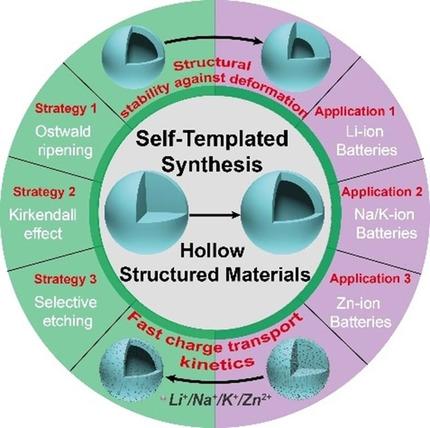当前位置:
X-MOL 学术
›
ChemNanoMat
›
论文详情
Our official English website, www.x-mol.net, welcomes your feedback! (Note: you will need to create a separate account there.)
Hollow‐Structured Electrode Materials: Self‐Templated Synthesis and Their Potential in Secondary Batteries
ChemNanoMat ( IF 3.8 ) Pub Date : 2020-08-10 , DOI: 10.1002/cnma.202000272 Si‐Qi Lu 1, 2 , Yong‐Gang Sun 1, 3 , Yan‐Song Xu 1, 2 , Si‐Jie Guo 1, 2 , An‐Min Cao 1, 2 , Li‐Jun Wan 1, 2
ChemNanoMat ( IF 3.8 ) Pub Date : 2020-08-10 , DOI: 10.1002/cnma.202000272 Si‐Qi Lu 1, 2 , Yong‐Gang Sun 1, 3 , Yan‐Song Xu 1, 2 , Si‐Jie Guo 1, 2 , An‐Min Cao 1, 2 , Li‐Jun Wan 1, 2
Affiliation

|
Hollow‐structured electrode materials have found broad applications in secondary batteries. The built‐in cavity of the prepared materials shows favorable features such as structural stability against volumetric deformation, good reservoir for electrolyte, and fast charge transport kinetics, which are highly efficient to improve the electrochemical performance of the electrode materials, particularly their cycling stability and high rate capability. However, the full potential of hollow‐structured materials is restrained by their limited synthesis capability, which currently relies on template‐based protocols with well‐known challenges in both product yield and operational convenience. In this review, the recent progress on different synthetic methodologies for the creation of hollow structures without the use of extra templates is summarized. Starting from solid precursors, focus is laid on the formation mechanisms for the creation of a cavity inside the electrode materials, and subsequently different driving forces such as Ostwald ripening, Kirkendall effect, and selective etching of an inhomogeneous particle are discussed, highlighting the self‐templated processes as designable and scalable ones with good control on the key structural characters. Furthermore, the applications of hollow structures in different kinds of battery systems are discussed in terms of building up a clear structure‐performance relationship of the electrode materials. Finally, we provide a perspective on the development trends of self‐templated construction of hollow structures.
中文翻译:

中空结构电极材料:自模板合成及其在二次电池中的潜力
中空结构电极材料已在二次电池中得到广泛应用。所制备材料的内置腔体具有良好的特性,例如抗体积变形的结构稳定性,良好的电解液储存能力和快速的电荷传输动力学,这些特性对于提高电极材料的电化学性能(特别是其循环稳定性和稳定性)非常有效。高速率能力。但是,中空结构材料的全部潜力受到其有限的合成能力的限制,该能力目前依赖于基于模板的方案,在产品产量和操作便利性方面都面临着众所周知的挑战。在这篇综述中,总结了在不使用额外模板的情况下创建空心结构的不同合成方法的最新进展。从固体前体开始,重点放在在电极材料内部创建空腔的形成机制,随后讨论了不同的驱动力,例如奥斯特瓦尔德熟化,柯肯德尔效应以及对不均匀颗粒的选择性蚀刻,突出了自模板化流程是可设计且可扩展的流程,可以很好地控制关键结构特征。此外,从建立明确的电极材料的结构性能关系出发,讨论了空心结构在不同类型电池系统中的应用。最后,我们提供了空心结构自模板建筑发展趋势的观点。随后讨论了不同的驱动力,例如奥斯特瓦尔德(Ostwald)熟化,柯肯德尔效应和对非均质颗粒的选择性刻蚀,强调了自模板过程是可设计的且可扩展的,并且可以很好地控制关键结构特征。此外,从建立明确的电极材料的结构性能关系出发,讨论了空心结构在不同类型电池系统中的应用。最后,我们提供了空心结构自模板建筑发展趋势的观点。随后讨论了不同的驱动力,例如奥斯特瓦尔德(Ostwald)熟化,柯肯德尔效应和对非均质颗粒的选择性刻蚀,强调了自模板过程是可设计的且可扩展的,并且可以很好地控制关键结构特征。此外,从建立明确的电极材料的结构性能关系出发,讨论了空心结构在不同类型电池系统中的应用。最后,我们提供了空心结构自模板建筑发展趋势的观点。突出自我模板化流程,使其具有可设计和可扩展的流程,并且可以很好地控制关键结构特征。此外,从建立明确的电极材料的结构性能关系出发,讨论了空心结构在不同类型电池系统中的应用。最后,我们提供了空心结构自模板建筑发展趋势的观点。突出自我模板化流程,使其具有可设计性和可扩展性,并且可以很好地控制关键结构特征。此外,从建立明确的电极材料的结构性能关系出发,讨论了空心结构在不同类型电池系统中的应用。最后,我们提供了空心结构自模板建筑发展趋势的观点。
更新日期:2020-08-10
中文翻译:

中空结构电极材料:自模板合成及其在二次电池中的潜力
中空结构电极材料已在二次电池中得到广泛应用。所制备材料的内置腔体具有良好的特性,例如抗体积变形的结构稳定性,良好的电解液储存能力和快速的电荷传输动力学,这些特性对于提高电极材料的电化学性能(特别是其循环稳定性和稳定性)非常有效。高速率能力。但是,中空结构材料的全部潜力受到其有限的合成能力的限制,该能力目前依赖于基于模板的方案,在产品产量和操作便利性方面都面临着众所周知的挑战。在这篇综述中,总结了在不使用额外模板的情况下创建空心结构的不同合成方法的最新进展。从固体前体开始,重点放在在电极材料内部创建空腔的形成机制,随后讨论了不同的驱动力,例如奥斯特瓦尔德熟化,柯肯德尔效应以及对不均匀颗粒的选择性蚀刻,突出了自模板化流程是可设计且可扩展的流程,可以很好地控制关键结构特征。此外,从建立明确的电极材料的结构性能关系出发,讨论了空心结构在不同类型电池系统中的应用。最后,我们提供了空心结构自模板建筑发展趋势的观点。随后讨论了不同的驱动力,例如奥斯特瓦尔德(Ostwald)熟化,柯肯德尔效应和对非均质颗粒的选择性刻蚀,强调了自模板过程是可设计的且可扩展的,并且可以很好地控制关键结构特征。此外,从建立明确的电极材料的结构性能关系出发,讨论了空心结构在不同类型电池系统中的应用。最后,我们提供了空心结构自模板建筑发展趋势的观点。随后讨论了不同的驱动力,例如奥斯特瓦尔德(Ostwald)熟化,柯肯德尔效应和对非均质颗粒的选择性刻蚀,强调了自模板过程是可设计的且可扩展的,并且可以很好地控制关键结构特征。此外,从建立明确的电极材料的结构性能关系出发,讨论了空心结构在不同类型电池系统中的应用。最后,我们提供了空心结构自模板建筑发展趋势的观点。突出自我模板化流程,使其具有可设计和可扩展的流程,并且可以很好地控制关键结构特征。此外,从建立明确的电极材料的结构性能关系出发,讨论了空心结构在不同类型电池系统中的应用。最后,我们提供了空心结构自模板建筑发展趋势的观点。突出自我模板化流程,使其具有可设计性和可扩展性,并且可以很好地控制关键结构特征。此外,从建立明确的电极材料的结构性能关系出发,讨论了空心结构在不同类型电池系统中的应用。最后,我们提供了空心结构自模板建筑发展趋势的观点。



























 京公网安备 11010802027423号
京公网安备 11010802027423号